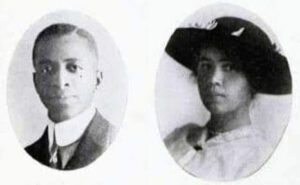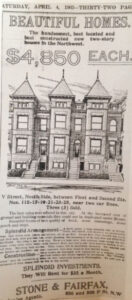History of the Bloomingdale Civic Association
Get Involved
The Bloomingdale Civic Association is always looking for neighbors to take an active role in our activities.

Frank (First BCA President) and Edna Brown Coleman
The Bloomingdale Civic Association was established in June 1921 with Frank Coleman as its first president. The Bloomingdale Civic Association is an historic civic association organized from the interests of a group of residents of Quincy Place, NW and was reported to be of the most aggressive and progressive civic associations in the District of Columbia, this according to article written in the Washington Afro American on August 4, 1951. In a later article published in the Washington Afro American (December 10, 1955,) President Dwight Eisenhower blessed the association stating, “I was particularly delighted to see this organization staring to work. It is the kind of thing that appeals to a soldier’s heart: decide what to do then do it and stop talking about it…I will follow it every step of the way, certain that you are doing a great job for the United States of America.”
The Bloomingdale Civic Association, which serves the Northwest area of the District bounded on the South by Florida Avenue, on the North by Michigan Avenue, on the East by North Capital Street, and on the West by 3rd Street, west of North Capital Street, both North and South of Rhode Island Avenue. The U. S. Soldiers’ Home, Washington Hospital Center, Children’s National Medical Center, the main Catholic University campus and Trinity University are to the North; LeDroit Park and Howard University are to the West.
Bloomingdale was the country estate of George and Emily Beale members of a prominent military family. In 1834, George Beale deeded land and right-of-way to springs on his Bloomingdale estate to the City of Washington as a water supply for the Capitol. Both General Ulysses S. Grant and President Abraham Lincoln were visitors to his home. In 1887, the Bloomingdale estate was divided among Emily Beale’s heirs and sold to several real estate developers.

1903 Ad for New Bloomingdale Houses
During World War I, Washington experienced a growth spurt, and areas North, Northwest and East of the Bloomingdale area. This paved the way for African American home ownership in the Bloomingdale area despite the fact homes in some sections of the community had covenants prohibiting African Americas from owning, renting, or using the homes in any way. These covenants had been added to deeds during the wave of segregation and Jim Crow legislation in the District of Columbia during 1890s and early 1900s. Some areas of the Bloomingdale community remained exclusively white until the mid-1950s.
African Americans began buying homes in Bloomingdale in the late 1920s. Early African American residents of the community were drawn to Bloomingdale because as a community it was seen as a neighborhood for African American professionals – possibly because of its proximity to Howard University. The Bloomingdale community gradually became one of the first stable African American communities in Washington, and section of Washington where many African American lawyers, teachers, pastors, physicians, dentists, professors at Howard University and other African American professionals were able to buy homes in area. The community spirit is deeply embedded along the streets of the Bloomingdale Community.
Today, the Bloomingdale community remains a densely populated area with primarily Victorian classic brick single-family row homes with their original architecturally ornamentation and brickwork. The neighborhood is returning to its historical roots as a diverse and thriving neighborhood. Longtime residents live next to young professionals and their families. The streets are abuzz with the laughter of children. Passersby are greeted warmly by residents sitting out enjoying what Bloomingdale has to offer – a sense of community.
Over the years, Bloomingdale Civic Association has been a leader in revitalizing and improving the quality of live for residents of Bloomingdale.
The goals of the Bloomingdale Civic Association are to create a process and environment for revitalizing its cultural and heritage needs, inspiring and motivating everyone to discover and express their values, talents, and strengths. They aim to develop a stable community with resources that assure the survival and protection of residents and visitors in the Bloomingdale community against displacement and other unjust or overwhelming interferences. Just as betano casino strives for fairness and enjoyment in gaming, the association seeks to achieve economic vitality with full employment, adequate consumer goods and services, quality education for young people, sufficient income to meet their needs, and the resources necessary for the continued health of the community.
Today, the Bloomingdale Civic Association seeks to maintain and continue its presence and ability to enhance the quality of life for all residents of the community. It also continues to emphasize beautifying its neighborhood, education, affordable housing, employment, and targeted business expansion and development.
